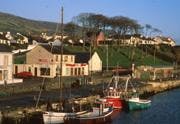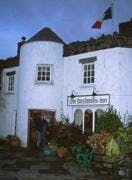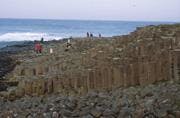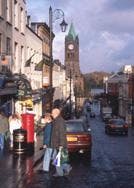Business is good for Hugh McDaid, finally. Political unrest is on the downswing, the economy is on the upswing, and as a result his small pub in the Northern Ireland town of Londonderry is often filled to overflowing.
"It's not just locals," says McDaid, as he looks over tables filled with plates of fish and chips and bowls of Guiness stew. "Tourists are beginning to come." He smiles and hails a waitress to bring another round of hot Irish coffee.
Northern Ireland is possibly one of the only places in the world where touring is easy but tourists are few. In other words, "the water's drinkable, the language is mostly understandable, at least to Americans, and the roads are off-the beaten track," says one gentleman, raising his glass in a toast.
Last year fewer than a million Americans visited the island of Ireland, but only seven percent, less than 70,000, crossed the border into Northern Ireland. Even fewer made it past the capital city of Belfast to the walled town of Londonderry, often called Derry.
Why? The Troubles scared them off. For thirty-five years there's been strife between Protestants who want to maintain ties with England and Catholics who want to fully unite with the 26 counties that make up the Republic of Ireland. Then, in September 2005, the Irish Republican Army (IRA), which was determined to force the British out of Northern Ireland, agreed to lay down their arms.
Even before the landmark agreement, it was only the perception of danger that kept visitors away. Northern Ireland has the second lowest crime rate of any country in Europe.
But now it looks as if peace is truly a possibility, so expect tourists to come in droves.
My husband and I divided our visit to Northern Ireland into two parts: the Antrim Coast and Derry.
Driving along the the northern coast of County Antrim-also called the Causeway Coast-was an almost other-worldly experience. The road winds along sixty miles of coast, with crashing waves on one side, fairy-tale glens on the other.
The people's brogue is thick here, as is the atmosphere, which is heavy with a misty dampness that would be annoying in other places but here seems only to heighten the mystical atmosphere. Had a leprechaun jumped out of the greenery, it would have seemed perfectly natural.
We wanted to explore each little village, but the pull of the coast was so strong that we limited ourselves to two-Cushendun with its picturesque Cornish cottages, and Bushmills, home of the world's largest distillery. "Old Bushmill" was licensed in 1608, which makes it the oldest legal distillery in the world. A 45-minute tour is a prelude to time at the tasting bar, where the hearty can learn first hand the difference between Irish and Scotch whiskies. (There are hot toddys for the timid.)
The nearby Bushmills Inn Hotel dates back to 1820, but a 1987 renovation retained the historic charm while adding modern comfort. The crackling fire in the fireplace lured us to settle in, and while we only intended to rest for a minute, we stayed for most of the afternoon.
Finally we roused ourselves to go to the Giant's Causeway, only two miles away, where the rocky landscape contrasts starkly with the lushness of the glens. The Causeway is a UNESCO World Heritage site and Northern Ireland's top tourist attraction. Columns of rock create a "geological freak" of 40,000 basalt columns, some of which are 40 feet high.
From above the stone columns, mostly hexagonal, it looked like a massive jigsaw puzzle, each column neatly wedged against its neighbors. Our guidebook insists they were the result of volcanic eruptions-but the guidebook was written by an American. The Irish know they were the work of Finn McCool, the grand Celtic hero. As we walked down the curving path to the sea, where the formations towered above us, mythology made more sense than geology.
There are more than eighty golf courses in the area, including championship courses like Royal Portrush and Royal County Down, but we had a decision: golf or the walled city of Derry. With a longing glance at the manicured greens, we headed on to Derry, where McDaid has his pub. By the time we got there, the winds were lashing, threatening to turn our umbrellas inside out. But inside the pub the atmosphere was as nourishing as the food and as warm as the drink. We'd obviously made the right choice.
By the time we were nicely thawed, the winds had died down, though as McDaid said, the day was still "soft." We walked the streets, narrow, steep lanes lined with brightly-painted houses topped with pitched roofs. In the United States a town like this would be an artists' colony, filled with equal parts local art and imported kitsch.
But Derry is more about history than art. Its past is both its charm and its nemesis. The town's location on a hill overlooking the sea made it strategically important and dangerously vulnerable. A mile-long wall, eighteen-feet thick and topped with an old cannon, surrounds the city, making Derry the only completely enclosed town in Ireland.
Other attractions, from the Tower Museum to the Guildhall, with its many stained glass windows, made for an interesting afternoon, but for the most part, the town lacks a tourist infrastructure. Despite several new hotels, most visitors see it less as a destination to be explored than as a base for nearby activities.
But the infrastructure, and the tourists, will come soon enough. Meanwhile, Derry is authentic today but it may be overly cute, and crowded, tomorrow.
Carpe diem!
For more information: www.discovernorthernireland.com










